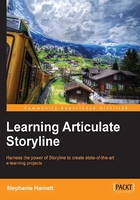
Chapter 3. Adding Interactivity
Storyline has two powerful features at the core of its authoring environment: states and triggers. States can change the way an object appears and triggers can add action to your story. The combination of these two features creates an endless variety of interactions.
Interactivity is really all about action. Rarely is something interactive without a resulting action. An example would be clicking or touching a button that displays the next slide. In Storyline, the button is the object, the click/touch of the button is the event and moving to the next slide is the action. But action can also occur based on a condition rather than user input. For example, a slide (object) can automatically advance to the next slide (action) when the timeline ends (event).
States change the appearance of an object. For example, when a button is clicked or touched, it changes color from green to red. The change of color is a change of state from the default green (normal) to red (selected). State changes occur based on some kind of action: whether caused by user input or by a condition.
This chapter covers the basics of adding action to a story; both user interaction and conditional actions in addition to controlling object appearance and behavior.
In this chapter you will learn:
- More about states and triggers
- How to add hyperlinks and buttons to a slide's content
- Additional formatting tips to add finesse to your example story
- How to quickly publish to validate functionality